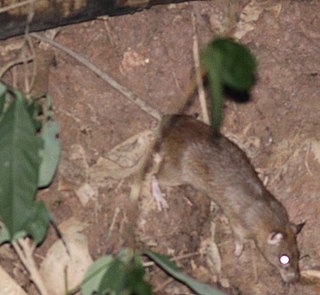
Rattus is a genus of muroid rodents, all typically called rats. However, the term rat can also be applied to rodent species outside of this genus.

The lesser bandicoot rat, Sindhi rice rat, Bengal rat or Indian mole-rat is a giant rat of Southern Asia, not related to the true bandicoots which are marsupials. They can be up to 40 cm long, are considered a pest in the cereal crops and gardens of India and Sri Lanka, and emit piglike grunts when attacking. The name bandicoot is derived from the Telugu language word pandikokku, which translates loosely to "pig-rat". Like the better known rats in the genus Rattus, bandicoot rats are members of the family Muridae. Their fur is dark or (rarely) pale brown dorsally, occasionally blackish, and light to dark grey ventrally. The head-body length is around 250 mm, and the uniformly dark tail is shorter than the head-body length.

Hutias are moderately large cavy-like rodents of the subfamily Capromyinae that inhabit the Caribbean islands. Most species are restricted to Cuba, but species are known from all of the Greater Antilles, as well as The Bahamas and (formerly) Little Swan Island off of Honduras.

Bandicota is a genus of rodents from Asia known as the bandicoot rats. Their common name and genus name are derived from the Telugu language word pandikokku (పందికొక్కు). DNA studies have found the group to be a monophyletic clade sister to the radiation of Molucca and Australian Rattus species as part of the paraphyletic Rattussensu lato.

The painted tree-rat is a species of spiny rat from Brazil, restricted to north-eastern Bahia in eastern Brazil. It is the only species in the genus Callistomys.
Owl's spiny rat is a rodent species in the family Echimyidae found in Brazil. It is the only species in the genus Carterodon. Owl's spiny rat has evolved characteristics such as a heightened ability to dig in open grasslands during times of environmental change.
The giant tree-rat is a species in the family Echimyidae, the spiny rats. It is the only species in the monotypic genus Toromys. It is endemic to Brazil, where it occurs in the flooded forest along the banks of the Amazon River and its tributaries.
The tuft-tailed spiny tree rat is a spiny rat species from Brazil south of the Amazon River, where it has been found in grassland and gallery forest. It is the only species in the genus Lonchothrix. Very little is known about this rodent. It is small with an average adult weight of about 138 grams. It is nocturnal and solitary in habits.

Simons's spiny rat is a spiny rat species found in Bolivia, Brazil, Colombia, Ecuador and Peru. It was named for American scientific collector Perry O. Simons.
Mycosphaerella eumusae is a fungal disease of banana, causing Eumusae leaf spot. Its symptoms are similar to black leaf streak. M. eumusae is the predominant Mycospharella of banana in mainland Malaysia and in Thailand, and is present in Mauritius and Nigeria. Septoria eumusae is an anamorph of Mycosphaerella eumusae.
The fiery spiny mouse is a species of rodent in the family Muridae found in Kenya and Tanzania. Its natural habitats are dry savanna and rocky areas. It may be found as a commensal in human habitations.

The greater bandicoot rat or Indian bandicoot rat is a species of rodent in the family Muridae found in Bangladesh, China, India, Indonesia, Laos, Malaysia, Myanmar, Nepal, Sri Lanka, Taiwan, Thailand, and Vietnam[Pakistan]. It can grow to about 27–29 cm without including the tail which can grow to 28 cm. These should not be confused with marsupial bandicoots which inhabit Australia and neighbouring New Guinea, which were named after the bandicota rats.

The small white-toothed rat is a species of rodent in the family Muridae. It is found in Cambodia, Laos, Myanmar, Thailand, and Vietnam.

Neill's long-tailed giant rat is a species of rodent in the family Muridae. It is found in Thailand, Laos, Vietnam, and possibly Myanmar.

The lesser ricefield rat is a rodent in the family Muridae. The species was first described by Robert Swinhoe in 1871. It is found in China, Laos, Taiwan, Thailand, and Vietnam.

Savile's bustard is a species of bird in the family Otididae. Otididae are an Old-World and understudied family of birds mostly found in Afro-Tropical regions. It is found in Burkina Faso, Cameroon, Chad, Ivory Coast, Gambia, Mali, Mauritania, Niger, Nigeria, Senegal, and Sudan.

The armored rat is a species of rodent in the family Echimyidae. It is monotypic within the genus Hoplomys. It is found in Latin America, from northern Honduras to northwest Ecuador. It possesses a range of spines on its back and sides of the body.

The prehensile-tailed hutia is a small, furry, rat-like mammal found only in forests on Cuba. It is the only member of the genus Mysateles. It climbs and lives in trees where it eats only leaves, and it is threatened by habitat loss. The prehensile-tailed hutia is a member of the hutia subfamily (Capromyinae), a group of rodents native to the Caribbean that are mostly endangered or extinct.
Vincent's bush squirrel is a species of rodent in the family Sciuridae, named in honour of Jack Vincent. It is endemic to Mozambique. Its natural habitat is subtropical or tropical moist montane forests, and it is threatened by habitat loss.

Echimyinae is a subfamily of rodents belonging to the spiny rats family Echimyidae. It contains 14 arboreal genera—all the members of the tribe Echimyini, plus Callistomys—a few terrestrial genera, and a subaquatic genus (Myocastor).















